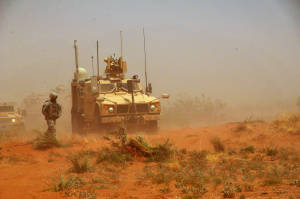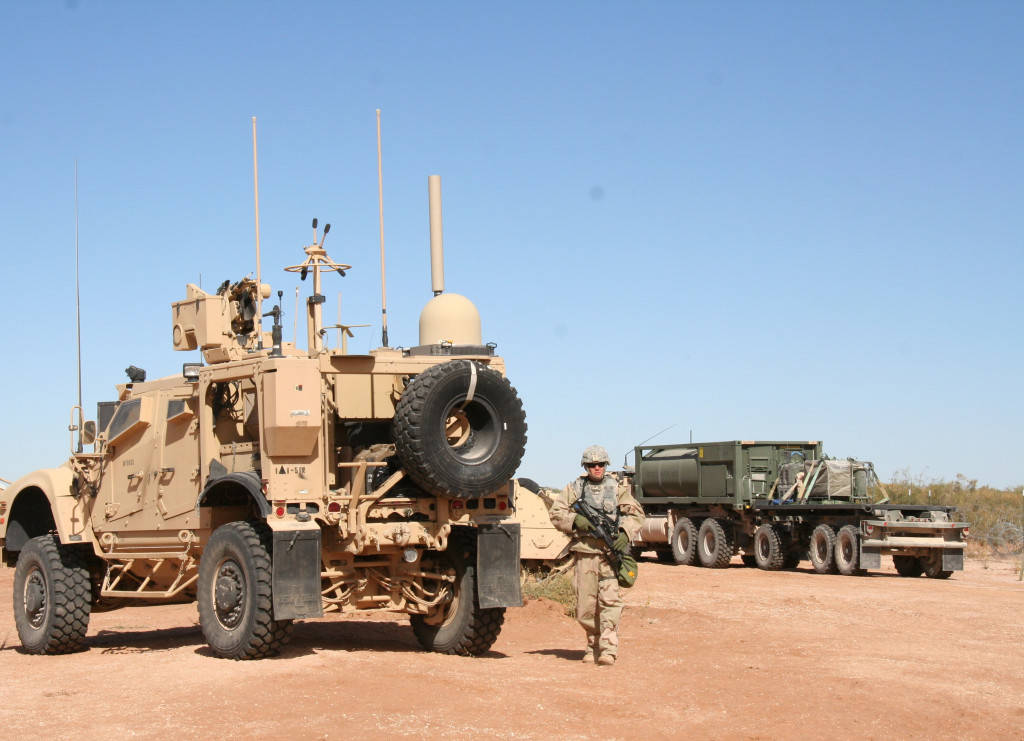U.S. Army Story by Claire Heininger
ABERDEEN PROVING GROUND, MD — The SNE is getting a mission makeover.
The Soldier Network Extension (SNE), which delivers the Army’s mobile tactical network backbone to the company level, is evolving from a vehicle used by the company commander to an information hotspot allowing other Soldiers to plug in, make phone calls and send and receive data from anywhere on the battlefield — from an Afghan polling place to an air assault observation point.
The changes, based on user feedback from Capability Set (CS) 13 fielded units and the Army’s Network Integration Evaluation (NIE) events, are also making the SNE more user-friendly through major reductions in startup and shutdown times, a simplified graphical interface and improved troubleshooting tools.
“That is going to be a game changer,” said Capt. Alexander Marotta, deputy communications officer (S6) for the 3rd Brigade Combat Team (BCT), 101st Airborne Division (Air Assault), which is currently training with CS 13. “Once we show people you can get into these things, hit start and all these systems will start up by themselves, that’s where we’re going to see more embracing of the systems. We’re going to see the Soldiers want to use it.”
The SNE is part of the Warfighter Information Network-Tactical (WIN-T) Increment 2 mobile network that enables Soldiers operating in remote and challenging terrain to maintain voice, video and data communications while on the move.
WIN-T Increment 2 began fielding in October 2012 with CS 13, the Army’s first integrated tactical communications package that provides connectivity across the BCT formation. Three CS 13-equipped units have since deployed to Afghanistan as Security Force Assistance Brigades (SFABs), which work alongside Afghan forces as they improve their capabilities and assume responsibility for the security of their country.
Both the SNE and its battalion-level counterpart, the Point of Presence (PoP), were initially fielded on Mine Resistant Ambush Protected (MRAP) platforms that have been employed by SFAB units to support the U.S. advise-and-assist mission. Leaders say they are leveraging the PoP as the Army originally intended: to conduct mission command away from their command posts.
“It eased the transition between command post and mounted operations,” said Maj. Gary Pickens, S6 for the 4th Brigade Combat Team, 10th Mountain Division (Light Infantry), which concluded its deployment in March. “In the past, when the commander gets in his vehicle, he goes from all of the capabilities in the command post to just an FM radio and (Blue Force Tracking). With the PoP that didn’t matter — the key leader still had access to all of these different systems. To send updates at the tip of the spear through multiple different means was a capability they enjoyed.”

The SNE is evolving from a vehicle used by the company commander to an information hotspot allowing other Soldiers to plug in, make phone calls and send and receive data from anywhere on the battlefield.
The SNE, however, has filled a different role. Units say they use it less frequently as a company command vehicle, and more often as a mobile, ad-hoc network access point that provides reachback connectivity for multiple personnel. For example, during April’s round of Afghan presidential elections, Soldiers from the 2nd Brigade Combat Team, 101st Airborne Division drove a SNE vehicle out to their assigned observation point near a polling place. There, they used the SNE to plug in multiple laptops for email, chat, and portal access, as well as to make Voice Over Internet Protocol (VOIP) satellite calls, allowing them to maintain full situational awareness of the election and associated security activities across the unit’s area of operations.
The SFABs have also leveraged their SNEs to support information exchange in the coalition environment. The PoP vehicles were based on the U.S. component of the coalition network, which enables partner nations to share critical information and a common operating picture. Units then configured select SNE vehicles to use the Army’s Secret Internet Protocol Router Network (SIPRNet), providing a U.S.-only communications capability as a complement to the PoP.
Back in the United States, the 3rd Brigade Combat Team, 101st Airborne Division this spring conducted Operation Golden Eagle, the Army’s first brigade-size air assault mission since before Sept. 11, 2001. While the Fort Campbell, Ky.-based training exercise did not warrant using PoPs and SNEs for their traditional mobile purpose, the unit positioned a SNE at a convoy staging area to provide the brigade’s deputy commander with network connectivity to maintain situational awareness and send and receive reports.
“We did some very unique things with it,” Marotta said.
In addition to collecting insights and lessons-learned from the CS 13 BCTs, the Army is applying feedback from the 2nd Brigade Combat Team, 1st Armored Division (2/1 AD), gathered over the course of several NIE field exercises at Fort Bliss, Texas, and White Sands Missile Range, N.M. The semi-annual NIEs provide Soldier input on the value of various network and mission command systems while helping to develop tactics, techniques and procedures (TTPs) for using communications equipment on the battlefield.
After using the SNE in a variety of operational scenarios, the brigade’s leadership recommended that the SNE might not be the right match for a company commander, but because of its ability to enable critical Command and Control it should still be distributed at that echelon because it provides important connectivity to the upper tactical internet for access to full-motion video and other high-bandwidth information. In other words, they asked for the SNE to serve as a connection, not a tether.
“There is a debate right now on whether they need the SNE at the company level — seeing how powerful it can be, my answer is yes,” said Col. Thomas Dorame, the commander of 2/1 AD. “(But) I want company commanders to be lean and capable to move, rapidly close and destroy, not overburden them.”
Sgt. Martha Montes, a SNE operator in 2/1 AD, used the capability in a different role — as a “retrans” link to extend the range of the brigade network for NIE. She said the real-time access to data and ability to make satellite phone calls increased the tempo of operations and improved Soldier safety.
“The people that are in combat can go farther out now since we have the retrans set up, so they will be able to talk to brigade,” Montes said. “That is why our job is so important. If we don’t have comms, its over.”
The NIE has also provided a test bed to evaluate WIN-T Increment 2 integrated on different platforms, such as Strykers and tracked vehicles. Strykers integrated with PoPs and SNEs are taking part in a developmental test at Fort Bliss this month, which will be followed by an evaluation with a full Stryker battalion during NIE 15.1 in October-November.
The Stryker assessment is just one part of NIE 15.1’s Follow-on Operational Test and Evaluation (FOT&E) for WIN-T Increment 2, which will also focus on validating the system changes to reduce complexity, increase reliability and reduce dependence on Signal Soldiers to operate and maintain the equipment.
These enhancements, coupled with operational insights about the SNE’s evolving role, are expected to increase its utility on the battlefield for future CS fieldings.
“Soldiers deserve a network that is intuitive to operate and flexible to support their needs for various missions and formations,” said Lt. Col. LaMont Hall, product manager for WIN-T Increment 2. “With their help, we will make sure we match the right capability to the right users, develop the right TTPs and continue to simplify the network, so it gives commanders and Soldiers the information they need but keeps their focus on the fight.”
Source: Claire Heininger, “Network Hotspot Evolves With Soldier Input, U.S. Army PEO C3T, 6/24/2014


